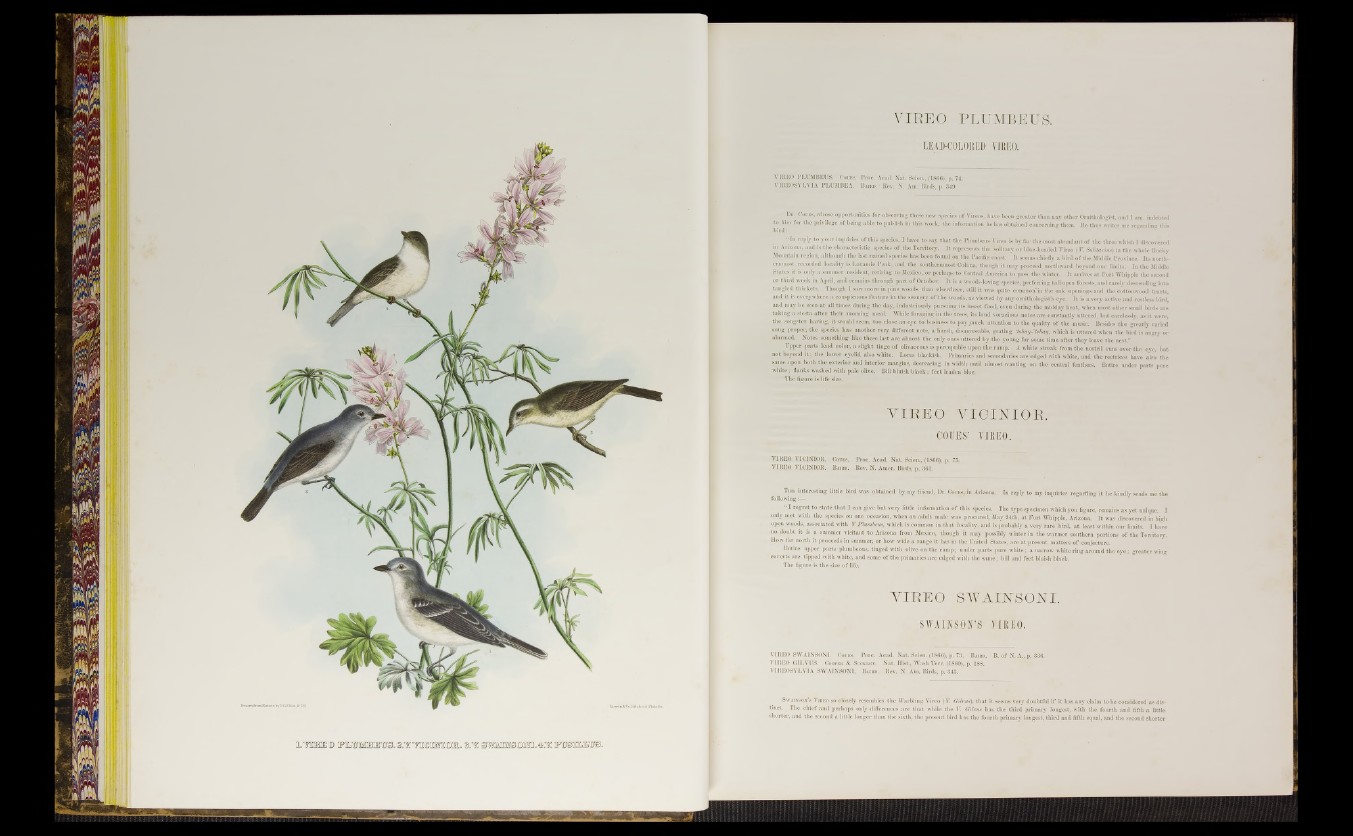
¡LTOEBE© IPILWMIETFS.g.^T2Smi(DI!i. ®Æ ©miESMOE.« JpqjndUHDB.
VIREO PLUMBEUS.
LEAD-COLORED VIREO.
VIREO PLUMBEUS. Coues. Proc. Acad N a t. Scien., (1866), p. 74.
VIREOSYLVIA PLUMBEA. Ba ird .- Rev. N. Am. Birds, p. 349
DR. Codes, whose opportunities for observing these new species o f Víreos, have been greater than any other Ornithologist, and I am indebted
to him for the privilege o f being able to publish in this work, the information he has obtained concerning them. He thus writes me regarding this
“In reply to your inquiries of this species, I have to say that the Plumbeus Vireo is by far the most abundant of the three which I discovered
in Arizona, and is the characteristic species of the Territory. It represents the solitary or blue-headed Vireo ( V. Soli/arius) in the whole Rocky
Mountain region, although the last named species has been found on the Pacific coast. It seems chiefly a bird of the Middie Province. Its northernmost
recorded locality is Laramie Peak, and the southernmost Colima, though it may proceed northward beyond our limits. In the Middle
States it is only a summer resident, retiring to Mexico, or perhaps to Central America to pass the winter. It arrives at Port Whipple the second
or third week in April, and remains through part of October. It is a woods-lovihg species, preferring tall open forests, and rarely descending into
tangled thickets. Though I saw more in p in e woods than elsewhere, still it was quite common in the oak openings and the cottonwood tracts,
and it is everywhere a conspicuous feature in the scenery of the woods, as viewed by any ornithologist’s eye. It is a very active and restless bird,
and may be seen at all times during the day, industriously pursuing its insect food, even during the midday heat, when most other small birds are’
taking, a siesta after th e ir morning meal. While foraging in the trees, its loud voracious notes are constantly uttered, but carelessly, as it were,
the sougster having, it would seem, too close an eye to business to pay much attention to the quality o f the music. Besides the greatly varied
song proper, the species lias another very different note, a harsh,'disagreeable, grating ‘May-'tshay, which is uttered when the bird is angry or
alarmed. Notes something like these last are almost the bn]y ones uttered by the young fo r some time after they leave the nest.”
Upper parts lead color, a slight tinge of olivaceous is perceptible upon the rump. A white streak from the nostril runs over the eye, but
not beyond it ; the lower eyelid also white. Lores blackish. Primaries and secondaries are edged with white, and the rectrices have also the-
same upon both the exterior and interior margins, decreasing in width until almost wanting on the central feathers. Entire under parts pure
white; flanks washed with pale olive. Bill bluish black; feet leaden blue.
The figure is life size.
VIREO V IO íRIOR.
: M U E S ’ VIREO.
VIREO VICINIOR. Codes. Proc. Acad. Nat. Scien., (1866), p. 75.
VIREO VICINIOR. Baird. Rev. N. Arner. Birds, p. 361.
This interesting little bird was obtained by my friend, Dr. Codes, in Arizona. In reply to my inquiries regaining it he kindly sends me the
“ I regret to state that I can give but very little information of this species. The type specimen which you figure, remains as yet unique. I
only met with the species on one occasion, when an adult male was procured, May 24th, at Port Whipple; Arizona. It was discovered in high
0E!» woods, associated with V Plumbeus, which is common in that locality, and is probably a very rare bird, at least within our limits I have
UP doubt it is a summer visitant to Arizona from Mexico, though it may possibly winter in the warmer southern portions of the Territory.
How far north it proceeds in summer, or how wide a range it has in the United States, are at present matters of conjecture.
Entire upper parts plumbeous, tinged with olive on the rump; under parts pure White; a narrow white ring around the eye; greater win«'
coverts are tipped with white, and some o f the primaries are edged with the same; bill and feet bluish black.
The figure is the size of life.
v i r e o swAEsrsojsri.
SWAINSON’S VIREO .
VIREO SWAINSONI. Codes. Proc. Acad. Nat. Scieu. (1866), p. 73. Baird. B. of N. A., p. 336.
VIREO GILVUS. Cooper & Sooklby. Nat. Hist., Wash Terr. (1860), p. 183.
VIREOSYLVIA SWAINSONI. Baird. Rev. N. Am. Birds, p. 343.
Swainson’s Vireo so closely resembles the Warbling Vireo ( V. Gilvus), that it seems very doubtful if it has any claim to be considered as distinct.
The chief and perhaps only differences are that while the V. Gilvus has the third primary longest, with the fourth and fifth a little
shorter, and the second a little longer than the sixth, the present bird has the fourth primary longest, third and fifth equal, and the second shorter